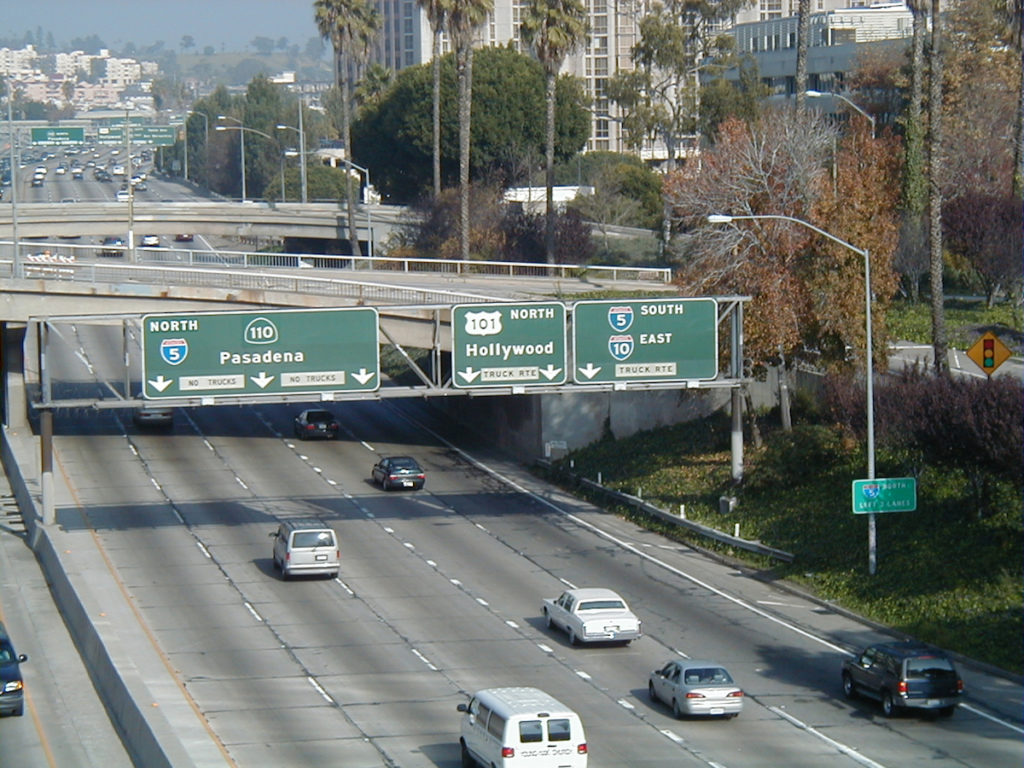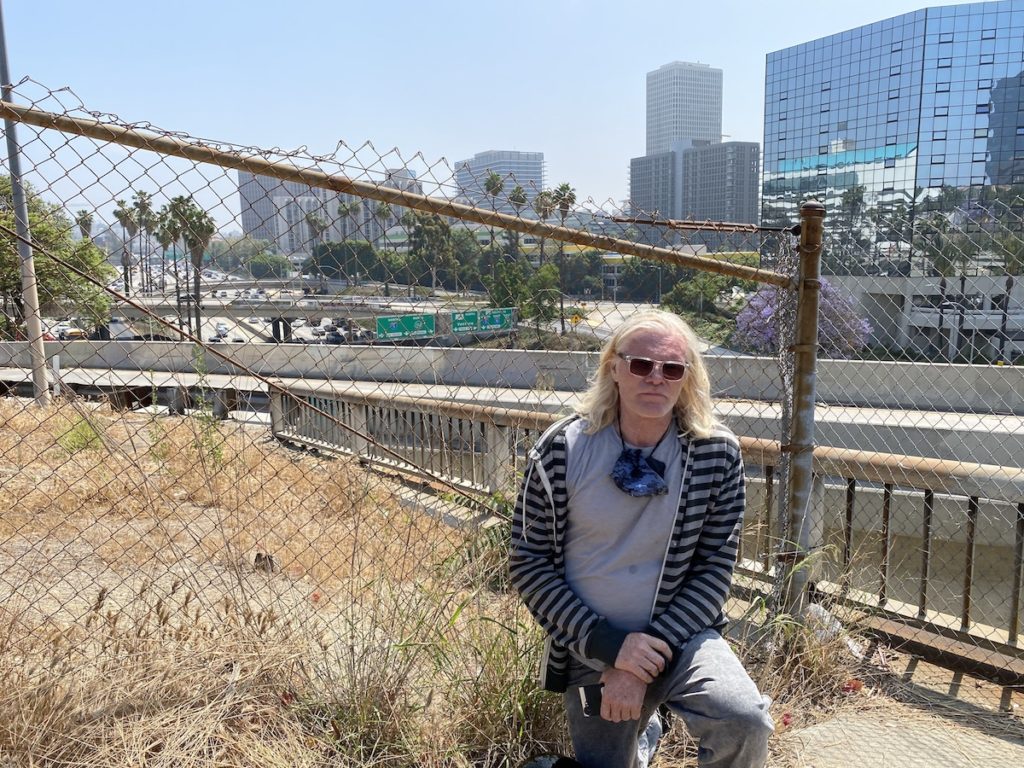
In the pre-dawn hours of August 5, 2001, Richard Ankrom got in his pick-up truck and drove out to a downtown L.A. freeway sign. He parked along an off-ramp near 4th and Beaudry Streets, stashed two large sheets of aluminum in the bushes, and took a deep breath. Ankrom needed a moment to reflect on the laws he was about to break in the name of art. “I was scared,” he recalled recently, perched on an overpass, staring down at the area where this occurred two decades earlier. “I stood there, just to kind of calm down, you know.”
There was no turning back now, he remembered thinking. He’d already spent the time and money to manufacture a near-undetectable replica of two pieces of freeway signage to exact industry specification. And in advance of their installation, he’d prepared a decal for his truck that read “Aesthetic De Construction,” created a phony work order in case anyone approached him, and cut his shaggy blond hair to a city-worker-appropriate length.
He’d also already enlisted his friends from the Brewery Art Colony, the artists’ studios in Lincoln Heights where he lived, to get up at the crack of dawn to document what would later become known as his infamous “Guerrilla Public Service” project — so he wasn’t about to reschedule just because he’d lost his courage. And anyway, after the signage — an Interstate 5 emblem and an accompanying green placard reading “NORTH” — had been made, it had to be put up. Otherwise, what was the point? “I had the idea and then I thought to myself, ‘If I make the sign, I’m gonna have to go through with it,’” he said.
This was the original germ of the idea: The California Department of Transportation had screwed up. For many years, if you were traveling north on the 110 in downtown Los Angeles and were intending to go north on the 5, there was no easily visible signage to prepare you for the sudden interchange. And it’s not just any interchange, either — it’s a strange corkscrew of an exit on the left side of the freeway, sneaking up on you at the end of a tunnel. Without a decent amount of warning, you would very likely miss it — and plenty of people certainly did — ending up halfway to Pasadena before realizing what had happened. Ankrom was one of those who had missed the exit before, so he decided to fix the problem himself.
A sign artist by trade, Ankrom wasn’t fazed by the initial part of his project. He downloaded a Caltrans manual, cross-checking the information by assessing an easily accessible freeway sign in person. He then cut the aluminum and painted the shield and placard, essentially by hand. On the back of the shield, he signed his name — an artist marking his work.
There was one part he couldn’t make himself, however, which was the circular reflectors that had to sit on top. But he was able to convince the company that made them that he needed the reflectors for a film project — which was not untrue: “I realized once I put that thing up, it’d be gone and nobody would know it happened, so it had to be documented,” he said.
Just after the sun came up on installation day, with video cameras rolling from various vantage points, Ankrom put on a hardhat and safety vest, hoisted a ladder up to the larger freeway sign apparatus, and climbed up to the plank with his work.
“I didn’t want to panic and work too fast, because it wouldn’t look normal,” he remembered. “So I was very conscious of how long I was taking to do it. I was like, ‘OK, slow down, calm down, don’t drop anything.’ I was psyching myself the whole time.”
There happened to be a Caltrans crew working nearby when Ankrom was up there, and he was told later that they gave him a good, long look. But ultimately no one questioned him. “They say if you’re dressed correctly and carry a clipboard around, you can get away with a lot of stuff,” he put it. (Also of note: It was still a pre-9/11 world — just barely.) Even so, after 20 or 30 minutes up there, carefully drilling the signs in as traffic zoomed by below, he arrived back at his truck drenched in sweat. “My hair was like I put my head under a faucet. I was soaked to the bone.”
Nevertheless, the installation went off without a hitch, and for a while, that was that. If anybody noticed the new addition, they didn’t suspect it was a forgery — and why would they? To Ankrom, it was something that needed to be done. It helped commuters. It was a service.
Ankrom got to work editing the footage, and some nine months later, after he posted it on a pre-YouTube video hosting site, the story was broken simultaneously by LA Weekly and the Downtown News. (The video — a bizarre and hypnotizing behind-the-scenes look at every step of the process — is its own work of art.) Almost immediately, he had a line of media teams waiting outside his studio to set up interviews for national news programs: CNN, Good Morning America, Tom Brokaw, the whole blitz.
Caltrans also weighed in after it was reached for comment by various media organizations. In a shocking moment of humility, they noted that, while they didn’t approve of Ankrom’s methods, they couldn’t deny the quality of his work. Not only would they not be pressing charges — they were going to leave his handiwork up. One Caltrans representative jokingly told ABC that they had a job application for Ankrom to fill out.
“That happened so fast,” Ankrom said, referring to the sudden media blitz, which died down about 24 hours later. “The next day it was all over. It was like, ‘Wow, did that really happen?’”
From that moment on, Ankrom’s “Guerrilla Public Service” project became a part of Los Angeles lore. For the next handful of years, his work was passed by millions of cars, with a precious group of them aware of the quiet rebellion whizzing by above. For some, it was a statement about doing it yourself; for others, a statement about the nature of art in a highway-ruled metropolis. In a subtle coronation, the Pulitzer Prize-winning art critic Christopher Knight even included Ankrom’s sign in a 2006 L.A. Times roundup of some of the best car-centric L.A. art, along with works by far better-known artists like Ed Ruscha and Catherine Opie.
And then one day, it was gone.
In 2009, during a larger project to replace freeway signs along the 110, Caltrans took down the larger sign upon which Ankrom’s work had been installed, and sent it to be recycled. Ankrom tried to track it down, but by the time he did, it was already crushed into a cube along with other signs. “I couldn’t even afford to buy the block,” he said, half joking. “That would’ve been kind of cool just to go, ‘There it is, it’s in there, I guess!’” It was a big loss, but there was one important victory: The new signs put up along that stretch of the freeway incorporated Ankrom’s design.
These days, Caltrans is less amused by Ankrom’s story than it was in 2001. When reached for comment, a representative didn’t want to talk about the specifics — instead preferring to state that they “very strongly discourage unauthorized persons from trespassing onto Caltrans right of way,” and that there are “legal penalties and serious personal liability” for doing so. Should you have an issue with something like signage, the representative recommends you “simply submit a Customer Service Request.” They assure you that you will get a response.

Now 65, Ankrom still lives at the Brewery Art Colony. His formerly blond hair is a soft silver now, but he’s just as busy as ever with sign assignments — projects for businesses such as Philippe’s and Universal Studios. He rides a motorcycle with flames painted on it.
Ankrom continues to keep an eye out for future “Guerrilla Public Service” opportunities — and he’s still a bit of a troublemaker in the name of art. In the years after the freeway sign was installed, he went around replacing American flags with custom ones adorned with extra stars, which represented added “territories” like Iraq and Afghanistan — the result of 21st-century American imperialism. (The “uniform and clipboard” approach once again worked like a charm.) But he hasn’t found anything quite like the project that made him famous.
“That freeway sign was sort of a perfect fit,” he admitted. “It was like, once in a lifetime. I may be the one-hit wonder and that’s it.”
With some distance behind it, Ankrom’s sign can now be seen as a pre-Banksy performance art piece — something that only makes sense within the larger context of its methods and location. Something that people enjoy because of its winking rebuke of the increasingly daunting civic dysfunction and stupidity of the modern era. “It does seem to fit within a very particular type of art being made in Southern California,” said Alissa Walker, a writer, co-host of LA Podcast, and noted fan of the sign during its heyday. She cited its relevance alongside more traditional highway murals that exist downtown, which are painted straight onto the cement walls.
It can also, perhaps, be understood as a playful form of “tactical urbanism,” a blanket term for small-scale improvements of city environments, like community gardens and renegade bike lanes. That methodology has grown more popular in the last several decades, but so has governmental pushback in cases where it’s not officially sanctioned. In New York, the Efficient Passenger Project, in which citizens installed convincing signage to guide subway riders to the right car, was condemned by the MTA, which promptly took the work down. In Oakland, the Pothole Vigilantes, a group of volunteers filling in potholes DIY-style a few years ago, mysteriously disappeared just as they were getting significant media attention — and after the city unequivocally told them to stop.
Walker thinks part of why Ankrom’s sign worked as well as it did was because of the way that it managed to circumvent a common criticism of Los Angeles in general: that the city doesn’t have enough communal spaces, and thus lacks a collective history and culture. “Every time I would see it I would get this really great feeling that maybe there were more shared secrets that certain people in L.A. knew,” she said. “Maybe this was one of those things, just for this very brief moment in time.”
Standing on the freeway overpass, looking down at where he had created his defining work of art, Ankrom is still surprised that people keep asking him about this ridiculous project of his, 20 years later. “It worked better than I thought,” he said. “A lot better than I thought, ’cause I really didn’t think anybody would care. When I make work, I really don’t imagine anybody giving a shit. I just do it for me.”
Thinking about it in 2021, though, it’s not lost on Ankrom that GPS may render the saga of his sign a little less impactful going forward — or at least, harder for younger generations to appreciate. Highway signs in the smartphone era are, after all, “almost useless,” he noted. “But you still need the sign, even with your GPS thing, to find your way.”